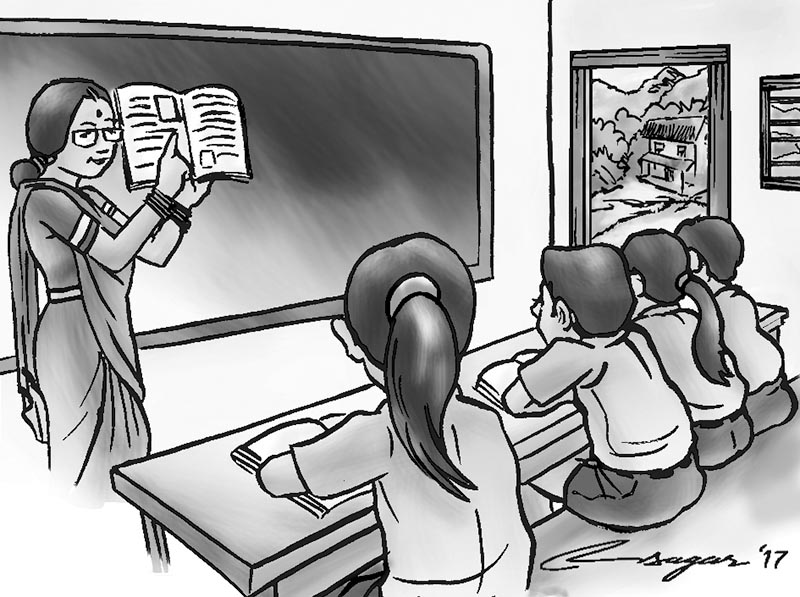Corruption in education: Policy and practice
The financial misuses occur in the funds released on the basis of student numbers. Although the funds have to be released as per the Flash Report that contains the number of students, it has not been done so accordingly
The education sector in Nepal has been susceptible for corruption over the years. Financial misuses in the education sector take place consistently in the areas of construction work, teachers’ salary and student grant as pointed out in the annual reports of Commission for the Investigation of Abuse of Authority (CIAA) and Office of the Auditor General (OAG). The key factors contributing to the misuses are delays in releasing budget, lack of local capacity and complex process for disbursing funds. In this context, it is imperative to reform education financing system learning from past experiences.
The delay in releasing funds as a result of contentious politics is a major challenge for public sector governance, including in the education sector in Nepal. In terms of construction grant, the delayed release of budget often leads to poor quality of work, increasing the risk of graft. Although the construction work involves a range of procedures-selection of beneficiary schools, signing of agreements, and monitoring of construction work following the guidelines, the fund is disbursed towards the end of the fiscal year complicating the process. This shows inherent bottlenecks in the existing fund flow system for its effective mobilization.
In the majority of schools, there are no school accountants especially at the primary level, and they are not provided with any kind of training. The mechanism for maintaining financial transparency in schools functions poorly. The policies for doing social and financial audit suffer from bottlenecks. Citizens barely participate in meaningfully and ask questions on such issues. Moreover, the power dynamics between head teacher, School Management Committee (SMC) chair and members and citizens or parents are unequal. The policy envisions lower education qualification for the SMC chair compared to that of the head teacher. The World Bank research in 2013 pointed out that a major proportion of SMC chairs and members were not as qualified as envisioned in the policy. Given this context, parents are unable to participate in the school’s auditing process and question critically on the pertinent issues.
The financial misuses also takes place in the area of teachers’ salary by releasing additional, double and ghost teacher salary, and such irregularities are repeated consistently over the years in the absence of accurate and reliable data. The responsibility to keep the records falls under the jurisdiction of DEOs, but they have failed to undertake this simple job. In addition, the teachers’ salary is disbursed following different steps as per the types of teachers. This means the procedural aspect of releasing the teachers’ salary is complex that often results in abuse of school finances. The financial misuses also occur in the funds released on the basis of student numbers. Although the funds have to be released as per the Flash Report that contains the number of students, it has not been done so accordingly. Consequently, textbook and scholarship funds are misused by inflating student numbers in most cases. Moreover, in the name of ghost schools textbook, scholarship and salary funds are transferred and misused repeatedly over the years. In some cases, the misuses have occurred with mutual understanding among the stakeholders. This is because schools should report data to DEOs through resource persons who can verify the number of students, teachers etc in the process.
The data management system related to education sector needs to be upgraded to overcome ongoing problems. Despite having mechanism in place for maintaining the data, the authorities miraculously fail to execute this simple duty. Consequently, it gives way for the misuse of public funds under various headings. Therefore, it is necessary to have a system to track required data as and when needed. The institutions, such as Department of Education should work towards this end so as to minimize the risk of corruption.
Although the existing policy envisions systems for managing education finances, problems persist in the procedure of flow of fund. For instance, release of education finance is often delayed both for recurrent and capitalexpenditure which results in fiscal mismanagement unintentionally. Since capital expenditure is released at the last stage, doing construction work within a very short period of time becomes impossible. Hence, it leads to leakage of public finance as construction work may not be done in a smooth manner. This indicates the need to reform the existing procedural aspects for the flow of public finance. In particular, funds could be transferred directly to the lower administrative levels instead of following complex bureaucratic procedures for the purpose. Theaccountability mechanism as envisioned for financial transparency functions poorly in most cases. The citizens or parents barely participate in social and financial auditing processes of schools primarily because of lack of awareness on the issues. This is also partly because concerned authorities hardly fulfill their respective responsibilities. The problem further gets exacerbated by inadequate infrastructure for managing school finance, such as lack of accountants in schools. In this context, these issues should be dealt in long term perspective with perseverance and persistence at different levels.
Budhathoki is a researcher, Martin Chautari






